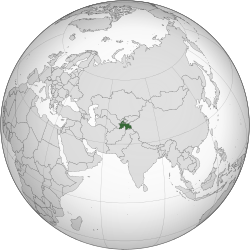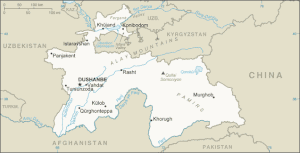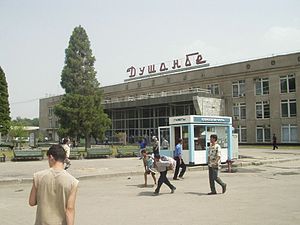Tajikistan: Sovereign state in Central Asia
Tajikistan is a country in Central Asia.
It was previously part of the Soviet Union. Tajikistan is a republic. The capital city is Dushanbe. The official language is Tajik,which is a dialect of Farsi (Persian).
Republic of Tajikistan
| |
|---|---|
| Anthem: Суруди Миллӣ (English: "National Anthem") | |
 Location of Tajikistan (green) | |
| Capital and largest city | Dushanbe 38°33′N 68°48′E / 38.550°N 68.800°E |
| Official languages | Tajik |
| Inter-ethnic language | Russian |
| Ethnic groups (2010) | |
| Demonym(s) | Tajik or Tajikistani |
| Government | Unitary dominant-party presidential constitutional republic |
| Emomali Rahmon | |
| Kokhir Rasulzoda | |
• Chairman of the Majlisi Milli | Mahmadsaid Ubaydulloyev |
| Legislature | Supreme Assembly |
| National Assembly | |
| Assembly of Representatives | |
| Formation | |
• Tajik ASSR | 27 October 1924 |
| 5 December 1929 | |
• Independence from the Soviet Union | 9 September 1991 |
• CIS full membership | 21 December 1991 |
• Recognized | 26 December 1991 |
• Admitted to the United Nations | 2 March 1992 |
• Current constitution | 6 November 1994 |
| Area | |
• Total | 143,100 km2 (55,300 sq mi) (94th) |
• Water (%) | 1.8 |
| Population | |
• 2019 estimate | 9,275,827 ((96th) ) |
• Density | 48.6/km2 (125.9/sq mi) (155th) |
| GDP (PPP) | 2018 estimate |
• Total | $30.547 billion (132nd) |
• Per capita | $3,354 (155th) |
| GDP (nominal) | 2018 estimate |
• Total | $7.350 billion (147th) |
• Per capita | $807 (164th) |
| Gini (2015) | 34 medium |
| HDI (2018) | medium · 127th |
| Currency | Somoni (TJS) |
| Time zone | UTC+5 (TJT) |
| Driving side | right |
| Calling code | +992 |
| ISO 3166 code | TJ |
| Internet TLD | .tj |
Tajikistan is a member of the Commonwealth of Independent States, the CIS. Tajikistan is eighth in size of CIS countries.
Geography
Tajikistan is one of the new countries in South-central Asia. It is west of China, north of Afghanistan and Pakistan, that is separated by a narrow 14 km strip of Tajik claimed land known as the Wakhan Corridor in the Pamirs, east of Uzbekistan and south of Kyrgyzstan.
Tajikistan is landlocked in the middle of the continent of Asia.
Its total area is only about 143,100 square kilometres (55,300 sq mi). It is slightly smaller than Wisconsin, USA. Tajikistan’s borders total to 3,651 kilometres (2,269 mi) long.



The climate has hot summers and mild winters.
Almost all of the country (85 percent) is mountainous with river valleys running across, however high altitude mountains of Pomir are in the eastern part of the country, (which is the west end of the Himalayas). The climate there is semiarid to polar. The mountains cover an area of about 120,000 km2 (46,000 sq mi). There are other countries within the mountain range. The mountains are between 3,600 to 4,400 metres (11,800 to 14,400 ft) high.
Karakul lake is located within a 52-kilometre-wide (32 mi) meteorite crater, which would have formed about 25 million years ago, or less than 5 million years ago.
History
The land that is now Tajikistan has been lived in since 4,000 BC. It has been under the rule of various empires throughout history, mostly the Persian Empires.
In the year 800, Islam came to north-east of Iran, (Nowadays called a part of this Land Tajikistan)
In 1868, Tajikistan became a Russian Colony. It later became a part of the Soviet Union.
On 9 September 1991, after long periods of mass protests against the Soviet Government, the Parliament of Tajikistan declared independence from Soviet Union, and held the first presidential elections.
Rahmon Nabiev, who ran the country during Soviet Union in the late 1970s and early 1980s, became its president. He was unable to bring any much-needed reforms to the country, and so there were protests in the capital city, Dushanbe. The government responded by organizing a pro-government demonstration, mainly made of old Communist Party members and people from the southeast of the country brought to the city. Anti-government protests did not stop, so the government gave weapons to the pro-government demonstrator. Then the Opposition armed themselves.
After this bloody civil war broke out. In which all of the new democratic parties, political organizations, and movements together with the political Islamic movements created an alliance, opposing the old communist government and southerners.
After the September 11, 2001 attacks, many American and French Soldiers came into the country.
Political structure
In 2010 a leaked US Embassy cable described Tajikistan as
"... The greatest obstacle to improving the economy is resistance to reform. From the President down to the policeman on the street, the government is characterized by cronyism and corruption. Emomali Rahmon and his family control the country's major businesses, including the largest bank, and they play hardball to protect their business interests, no matter the cost to the economy writ large... The government has limited opposition party operations and rejected electoral law reforms for the February 28, 2010, parliamentary elections. The Embassy does not expect the elections to be free and fair. There has been almost no coverage of opposition political parties by state media, and most of the population is unaware of the purpose of the elections..."
Provinces
Tajikistan is divided into 4 provinces.
| Division | ISO 3166-2 | Capital | Area (km²) | Pop (2008) |
|---|---|---|---|---|
| Sughd | TJ-SU | Khujand | 25,400 | 2,132,100 |
| Region of Republican Subordination | TJ-RR | Dushanbe | 28,600 | 1,606,900 |
| Khatlon | TJ-KT | Qurghonteppa | 24,800 | 2,579,300 |
| Gorno-Badakhshan Autonomous Province | TJ-BG | Khorugh | 64,200 | 218,000 |
References
- Poopak NikTalab. Sarve Samarghand (Cedar of Samarkand), continuous interpretation of Rudaki's poems, Tehran 2020, Faradid Publications {Introduction}
This article uses material from the Wikipedia Simple English article Tajikistan, which is released under the Creative Commons Attribution-ShareAlike 3.0 license ("CC BY-SA 3.0"); additional terms may apply (view authors). Content is available under CC BY-SA 4.0 unless otherwise noted. Images, videos and audio are available under their respective licenses.
®Wikipedia is a registered trademark of the Wiki Foundation, Inc. Wiki Simple English (DUHOCTRUNGQUOC.VN) is an independent company and has no affiliation with Wiki Foundation.

